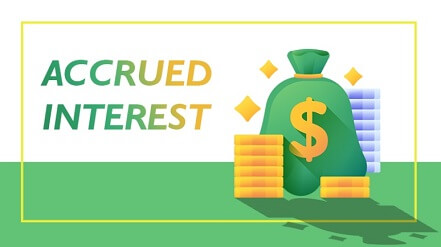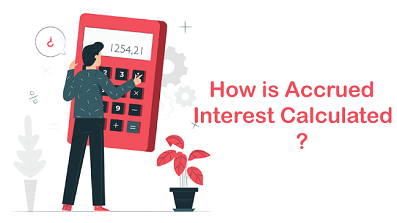What Is Accrued Interest, and Why Do I Have to Pay It When I Buy a Bond?What exactly is Accrued Interest?The total amount of interest earned on the bond since the last coupon date but has yet to be received is referred to as accrued interest. This is often in the form of accrued interest income for the lender or accrued interest expense for the borrower. Imagine the current bondholder decides to sell during the period between coupon payments. Even though the next coupon is not yet paid, the bondholder can still receive the interest payment at the time of sale. The bondholder still gets credit for the amount of time he or she held on to that bond, meaning the interest accrues between coupon payments on a pro-rated basis. The formula detailing the calculation of this accrued interest is outlined below in the article. 
The accrued interest is paid to the seller by the bond buyer; the issuer is not engaged in the process. Because the accumulated interest payment is added to the market price, bonds will always be more expensive than indicated. Accrued interest is added on top of the market price, rather than adjusted into the price, to limit the volatility that would occur in the bond market. This unneeded volatility would occur even if there were no changes in the bond market or the strength of a given bond; to address this possible issue, the accrued interest idea is employed. Why is it necessary to pay Accrued Interest?Accrued interest arises on an obligation, such as a bond, but has yet to be collected by a lender or paid by a borrower. Interest accumulates when a loan is made, or a bond coupon is paid. A bond is a financial obligation in which the owner (the lender) gets remuneration through interest payments. Coupons, or interest payments, are normally made every six months. During this time, bond ownership can be freely swapped between investors. The issue of ownership of interest payments, therefore, becomes a difficulty. The coupon payment may only be received by the record's owner. Nonetheless, the investor who sold the bond must be reimbursed for the time they had it. In other words, the previous owner must pay the interest accrued before the transaction. The interest paid on a bond compensates the borrower or issuer for the money provided. This borrowed money is also known as the principle. Upon maturity, the bondholder receives the principal amount. As with the coupon or interest payment, whoever is the legitimate owner of the bond at the time of maturity receives the principal amount. Suppose the bond is traded in the marketplace before actual maturity. In that case, the seller will get the bond's market value. The excess interest paid to the owner of a bond or other fixed-income asset is called the accrued interest adjustment. The amount paid is equivalent to the interest sum accrued since the bond's last payment date. What are the different types of Accrued Interest?Simple Interest This is the most elementary sort of interest, in which interest is determined as a percentage of the original loan amount and is compounded daily, weekly, or monthly. The interest is then applied to the principal balance and is calculated on the new, higher balance. Compound Interest This sort of interest is calculated by calculating interest not only on the original principal sum but also on any interest accrued since the last payment. This means that interest can compound swiftly over time since it earns interest. Accrued Interest Bonds These bonds have earned interest, but the bondholder must still receive interest payments. The bond issuer is obligated to pay the accrued interest later. Accrued Expenses These are expenditures that a business has incurred but has yet to pay. For example, suppose a corporation engages a consultant for a month and pays the consultant at the end of the month. In that case, the cost of the consultant's services is considered an accrued expense. How is Accrued Interest Calculated?
The concept behind calculating accrued interest is easy to understand. The sequence of formulas helps calculate the accrued interest on a potential bond purchase or sale. They are used in the following steps:
Factor = Time Held After the Last Coupon Payment / Time Between Coupon Payments
Interest Rate per Payment = Annual Interest Rate (Coupon) / Number of Payments per Year
Accrued Interest = Face Value of the Bonds x Rate (Step 2) x Factor (Step 1) Accrued Interest and the Bond MarketWhen buying bonds on the secondary market, the buyer must include the seller's accrued interest in the purchase price during payments. An investor who purchases a bond between the last coupon payment and the next coupon payment will get the entire interest on the scheduled coupon payment date since he will be the bondholder of record. But, because the buyer did not get the entire amount of interest generated during this period, they must pay the bond seller a portion of the money made by the seller before selling the bond. Imagine a bond paying a fixed coupon on June 1 and December 1. Now suppose this bond is sold by a bondholder on October 1. In such an instance, the buyer receives the entire coupon payment on December 1, the planned date. In this scenario, the buyer must pay the seller's interest from June 1 to October 1. In most circumstances, the bond's price includes accrued interest, which is then known as the full or dirty price. Accrued Interest and Convertible BondsA convertible bond contains an inbuilt option that allows bondholders to convert their bond into stock in the issuing firm or a subsidiary. Bondholders of an interest-paying convertible bond will receive coupon payments during the duration of the bond's ownership. When the bond is converted to shares of the issuer, the bondholder no longer gets interest payments. When a convertible bond is converted by an investor, the bondholder normally receives one last partial payment to cover the amount received since the last record payment date. Imagine that a bond's interest is payable each year on March 1 and September 1. Now suppose an investor changes his bonds to stock on July 1. In such a case, he will be reimbursed the interest accrued from March 1 to July 1. The accrued interest adjustment is represented by this last interest payment. ExampleAssume investor A acquires a $1,000 bond in the primary market with a 5% coupon paid semi-annually. Investor A chooses to sell the bond to Investor B after 90 days. Investor B must pay the current bond price plus accrued interest, the regular payment adjusted to account for the period investor A owned the bond. In this scenario, the bond would be $50 for the full year ($1,000 x 5%), and investor A would have held the bond for 90 days, or one-quarter of the recorded year (calculated by 90/360). As a result, the accumulated interest is $12.50 ($50 x 25%). As a result, investor B must pay Investor A the market value of the bond plus $12.50 in interest. The Bottom LineAccrued interest is recognized because of the difference in the timing of the financial flows, however, it is the amount that is pending to be paid or collected. It is adjusted to the face value of bonds to reimburse previous bondholders for the time they held the bonds. Consider accrued interest next time you think about buying or selling a bond. |
 For Videos Join Our Youtube Channel: Join Now
For Videos Join Our Youtube Channel: Join Now
Feedback
- Send your Feedback to [email protected]
Help Others, Please Share









